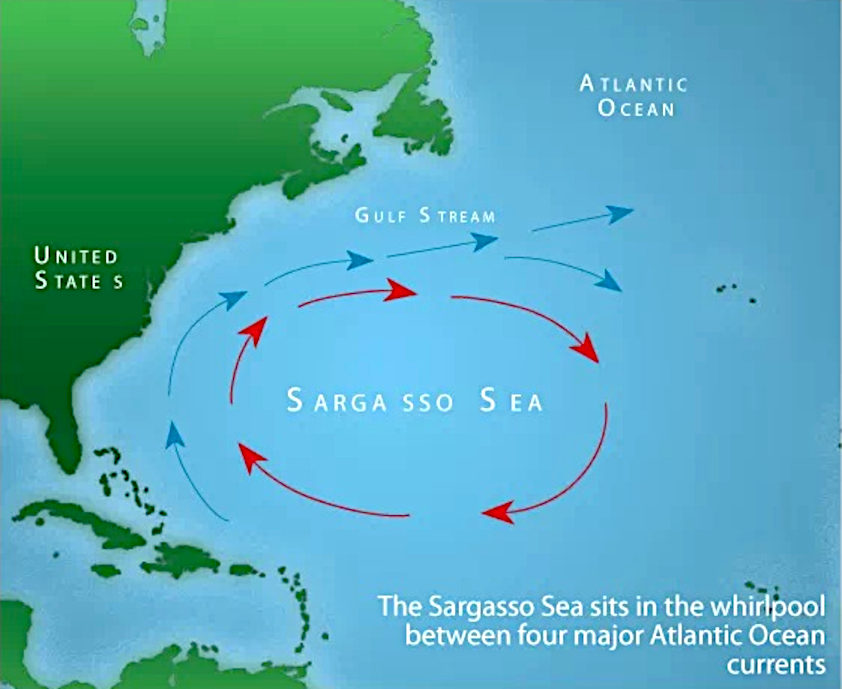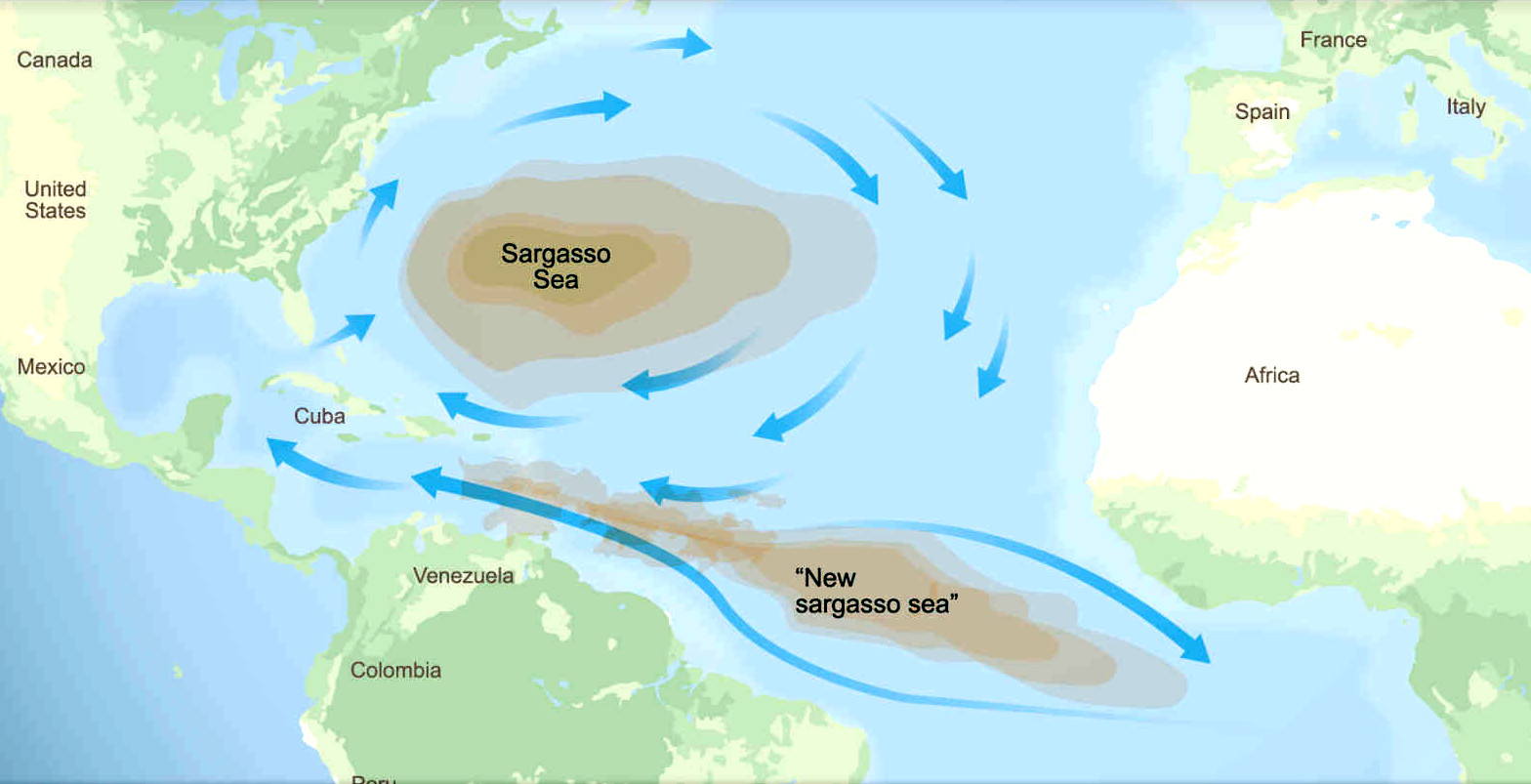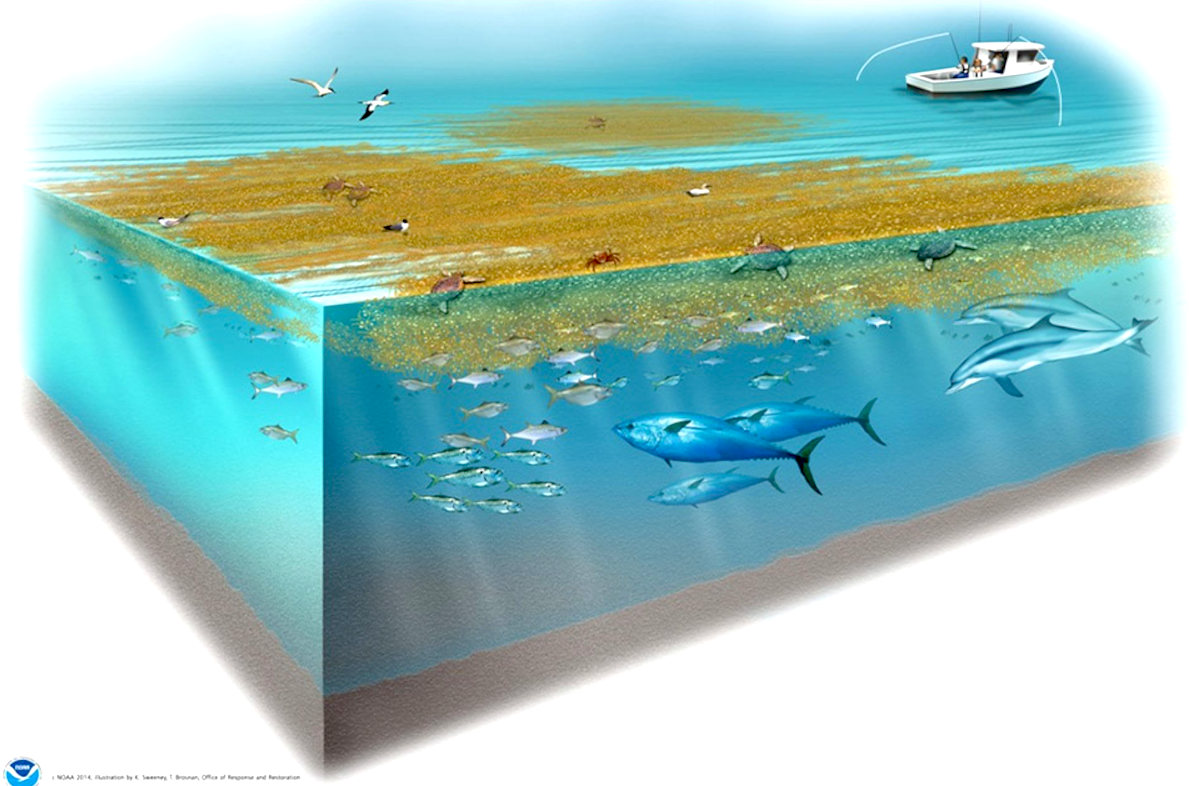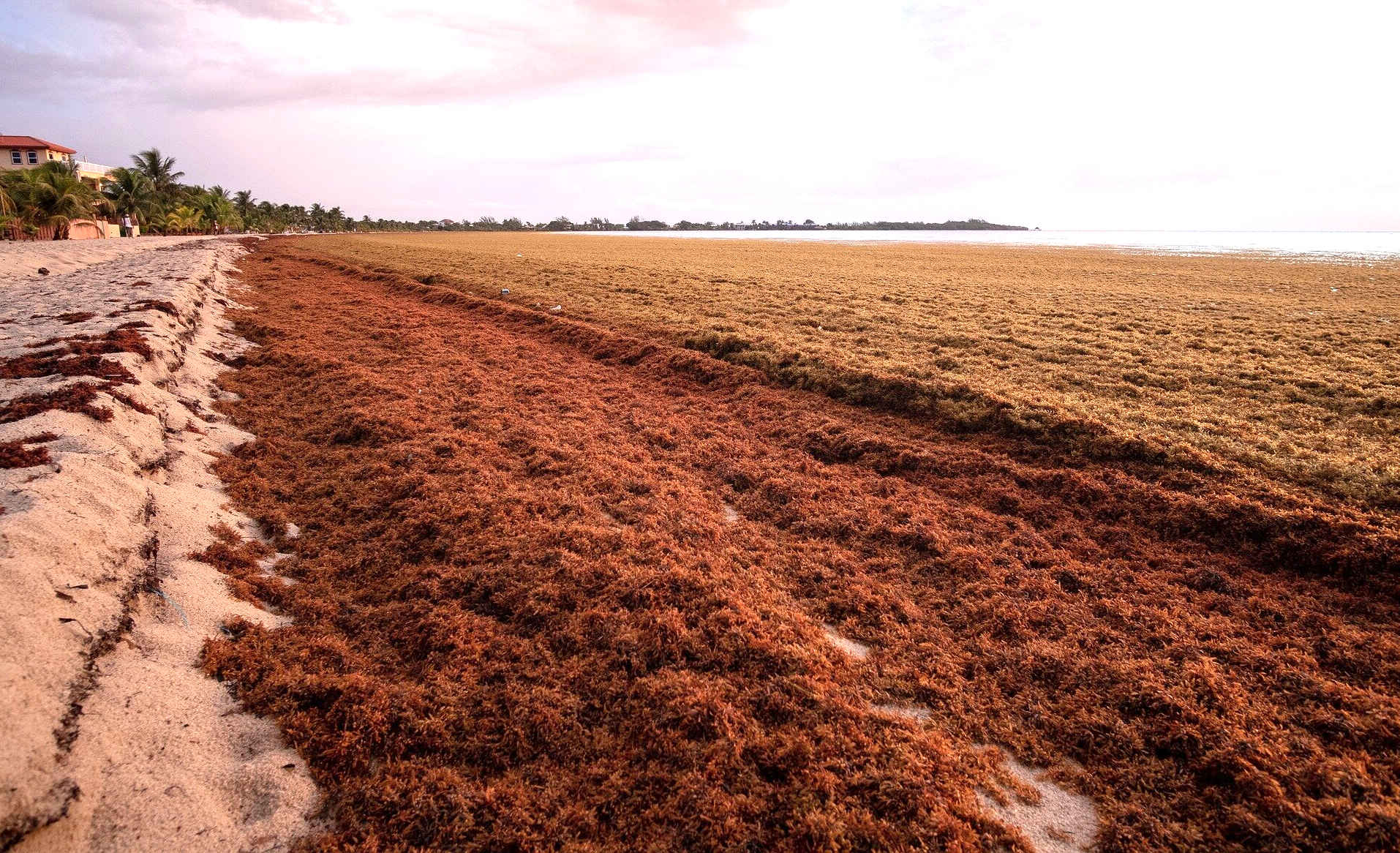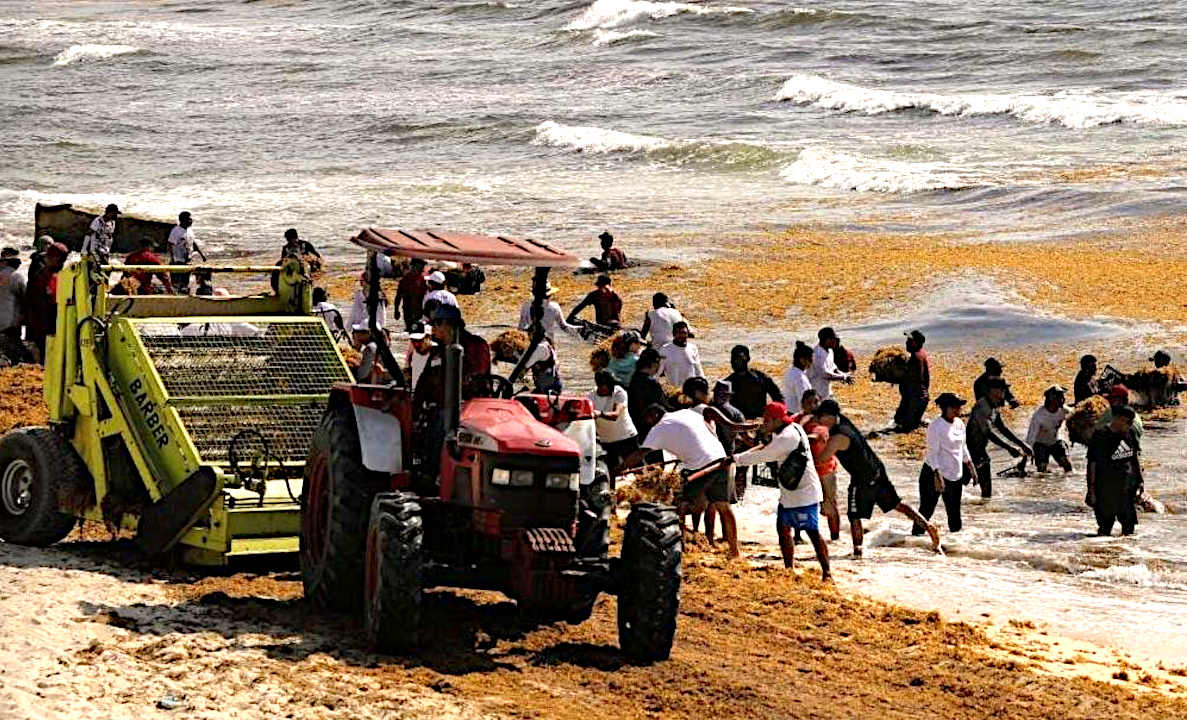|
THE SARGASSO SEA
|
|
|
Christopher Columbus, who crossed the Sargasso sea on his initial voyage in 1492, first mentioned that it encompasses the Bermuda islands. Because the sea is very calm with little wind, sailors since the time of Columbus mistakenly thought that seaweed itself is what trapped their ship. The mysteries of abandoned floating ships are associated with Sargasso Sea. There is no foundation to the belief that the amount and thickness of the weed can hinder a ship. The famed and feared Bermuda Triangle lies within the Sargasso Sea. The mystery of the Sargasso Sea was merely transposed later through the Bermuda Triangle.
The Sargasso Sea is a region of the
Atlantic Ocean bounded by four currents forming an ocean
gyre. Unlike all other regions called seas, it has no land boundaries. It is distinguished from other parts of the Atlantic Ocean by its characteristic brown Sargassum seaweed and often calm blue water.
Because the Sargasso Sea is bordered by oceanic currents, its precise borders may change. The Canary Current in particular is widely variable, and often the line utilized is one west of the Mid-Atlantic Ridge. A 2011 report based the sea's boundaries on several variables including currents, presence of seaweed, and the topography of the ocean floor, and determined that the specific boundaries of the sea were "between 22°38°N, 76°43°W and centred on 30°N and 60°W" for a total of around 4,163,499 square kilometres (1,607,536 sq mi).
The evidence appears to show that sargassum can spread past the North Atlantic, to the South Atlantic. Conditions may not be right just yet for spread to the Indian and Pacific oceans, but just like any invasive species, it only takes accidental transference, like the introduction or rabbits in Australia. As the population continues to grow, food production must follow, or those people will starve. But that means more fertilizer leaching into the ocean, via rivers. Pollution from which is not monitored or limited.
Rabbits were introduced to Australia with the arrival of the First Fleet in 1788. A population of 24 rabbits were released near Geelong in 1859 to be hunted for sport. The native quolls predated upon rabbits and prior to 1870, many accounts recorded quolls impeding their establishment on the mainland while island colonies thrived. Quolls were systematically exterminated by colonists to defend introduced species such as chickens. Within 50 years rabbits had spread throughout most of the continent with devastating impact on indigenous flora and fauna.
THE NEW SARGASSO SEA
Is there a new Sargasso Sea in the making, and could sargassum spread to other oceans and seas?
The answer to that and other similar worries, is that anything is possible. We grow potatoes from the Americas, all over the world. Provided that the conditions are right, sargassum could migrate. And as the world warms and the oceans become more polluted with effluents, it could be possible that the pestilence now a thing Caribbean Islanders have to routinely cope with, may explode onto the world stage, making our oceans into one giant toilet bowl; or septic tank.
Agreed that sounds a bit H. G. Wells: 'War of the Worlds," but then sargassum does look like a brown version of the red weed from Mars in that superb work of fiction.
As climate change warms the oceans, sargassum is likely to become more of a problem, without a solution at present. A modified version of the SeaVax, could be adapted to harvest the macro-algae in a giant cleanup operation, aimed at preventing the large brown seaweed from becoming a tourism disaster, by heading it off at the pass. Unfortunately, the Cleaner Ocean Foundation was forced to pull the plug on the ocean cleaning project, where funding applications failed to grasp the potential of the concept to be applied to other ocean cleaning duties, including oil spills. In 2020 the dream team comprised of 10 academic concerns and volunteer technology champions, reluctantly disbanded. In order to begin again, the costs would be around ten-twenty times that when operating on a not for profit basis. Nobody should be required to take such career risks, where the benefits are for governments and local businesses. There should be contracts for entrepreneurs who provide community solutions. Not promises.
SEAWEED
Where climate change is largely irreversible in today's political arena, with G7 and G20 policies based on growth and borrowing, both unsustainable practices - where we are already using the equivalent of 2.4 planets worth of natural resources, it seems the sargassum plague will only get worse. The Group of Seven, seem think we have a Planet B. We fear that the affected countries will have to fend for themselves. They need harvesting machines that run on renewable energy, capable of treating 24 million tons a year. They need the equivalent of the SeaVax concept, converted to recover floating macro algae.
Examples of which are:
The Sargasso Sea plays a role in the migration of catadromous eel species such as the European eel, the American eel, and the American
conger eel. The larvae of these species hatch within the sea, and as they grow they travel to Europe or the East Coast of North America. Later in life, the matured eel migrates back to the Sargasso Sea to spawn and lay eggs. It is also believed that after hatching, young loggerhead
sea
turtles use currents such as the Gulf Stream to travel to the Sargasso Sea, where they use the sargassum as cover from predators until they are mature. The sargassum
fish is a species of frogfish specially adapted to blend in among the sargassum seaweed.
Historic incidents of sailing ships being trapped there are due to the often calm winds of the horse latitudes.
POLLUTION
What is brown and stinks? G7 climate policies.
ACIDIFICATION - ADRIATIC - AEGEAN - ARCTIC - ATLANTIC - BALTIC - BAY BENGAL - BAY BISCAY - BERING - BLACK - CARIBBEAN - CORAL - EAST CHINA - ENGLISH CH - FINLAND - GOC - GULF GUINEA - GULF MEXICO - GULF THAILAND - GULF TONKIN - INDIAN - IONIAN - IOC - IRC - IRISH - MEDITERRANEAN - NORTH SEA - PACIFIC - PERSIAN GULF SEA JAPAN
- STH
CHINA - PLASTIC
- PLANKTON - PLASTIC
OCEANS - RED
SEA- SARGASSO
- SEA
LEVEL RISE - SOUTHERN
OCEAN - TYRRHENIAN
- UNCLOS
- UNEP
WOC
- WWF
AMAZON - BURIGANGA - CITARUM - CONGO - CUYAHOGA - GANGES - IRTYSH - JORDAN - LENA - MANTANZA-RIACHUELO MARILAO
- MEKONG -
MISSISSIPPI -
NIGER -
NILE -
PARANA -
PASIG -
SARNO - THAMES
- YAMUNA -
YANGTZE -
YELLOW -
ZHUJIANG
LINKS & REFERENCE
https://oceanservice.noaa.gov/facts/sargassosea.html https://oceanservice.noaa.gov/facts/sargassosea.html
|
|
|
This
website is Copyright © 2024 Climate Change Trust.
The name Bluebird and the blue bird in flight
|
